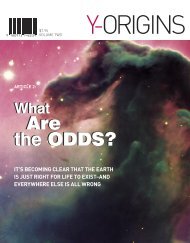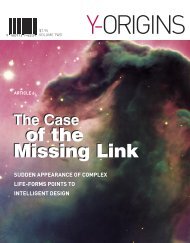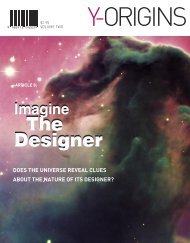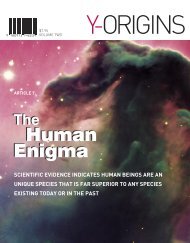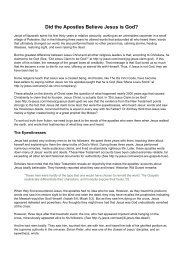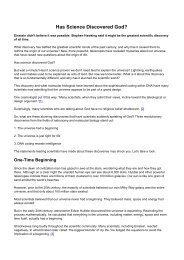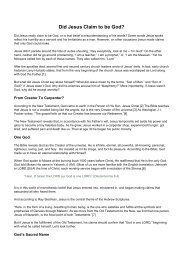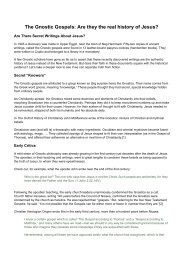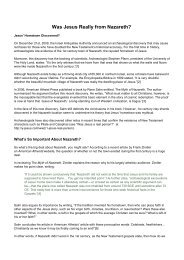cells5
Create successful ePaper yourself
Turn your PDF publications into a flip-book with our unique Google optimized e-Paper software.
$7.95<br />
VOLUME TWO<br />
Y-ORIGINS<br />
ARTICLE 5:<br />
The Language The<br />
of<br />
Our Cells<br />
THE LANGUAGE OF DNA PROGRAMMED<br />
BY A DESIGNER—OR BY CHANCE?
INSTRUCTIONS<br />
To view the layout and graphics, click on the Facing icon on the<br />
right side of your bottom tool bar in your Acrobat Reader © file. Try viewing at 75%.<br />
To read the article, click on the Single Page icon on the bottom right of your<br />
Acrobat Reader © file.<br />
To enlarge the print for easier viewing, click on the “+” by the<br />
magnifcation percentage in the middle of the tool bar at the top of the page.<br />
To move from one page to another, use your side scroll bar or click on the<br />
left or right arrow in the bottom tool bar.<br />
CLICK HERE to see other articles from Y-Jesus Magazine at www.y-zine.com<br />
Chief Editor: Larry Chapman<br />
Project Coordinator: Helmut Teichert<br />
Editorial Director: Rick James<br />
Design: Hydragraphik ® Studio ( www.hydragraphik.com )<br />
Sun Mountain Productions<br />
Article Editors: Rick James, Eric Stanford<br />
Copy Editor: Eric Stanford<br />
Writers: Larry Chapman, Rick James, Eric Stanford<br />
Y-ZINE<br />
PO Box 6017<br />
Great Falls, MT 59405<br />
Copyright 2006 by Bright Media Foundation and B & L Publications. All rights reserved.<br />
ISBN 0-9717422-3-5<br />
2 • Y-JESUS
The Language of Our Cells<br />
Click on the e-article title for contents<br />
THE LANGUAGE OF DNA PROGRAMMED BY A<br />
DESIGNER OR BY CHANCE? Page 6<br />
OF CLOTHES DRYERS, MOUNT RUSHMORE AND<br />
PRIME NUMBERS Page 6<br />
CSI: THE UNIVERSE Page 7<br />
PROBABLY INTELLIGENT Page 8<br />
WHAT A LITTLE STRAND CAN DO Page 9<br />
YOUR CELLS ARE TALKING Page 9<br />
LIFE IN A TEST TUBE? Page 10<br />
WHERE DID IT COME FROM? Page 10<br />
DNA BY DESIGN? Page 11<br />
ENDNOTES Page 12<br />
WHAT SETI IS LOOKING FOR Page 13<br />
ACKNOWLEDGMENTS<br />
I am indebted to Dr. Bill Bright, who passed away before this project was finished. Dr. Bright enthusiastically endorsed and<br />
contributed to the development of the material presented in this endeavor.<br />
Special thanks are also due to Rick James and Eric Stanford, who have both spent countless hours clarifying some of the concepts<br />
presented.<br />
Several others have contributed greatly to the writing of these articles, including Dr. Henry Brandt, Dave Chapman, Dr. Bert<br />
Harned, and New Testament scholar, Dr. Ron Heine. The valuable input from Brian Ricci, ‘Jamin Latvala, and the Campus Crusade<br />
staff at the University of Washington were especially helpful and constructive. Special thanks also are due Helmut Teichert of<br />
Bright Media, who has been the overall director of the project. Finally I would like to thank my wife, Marianne, for inspiring me to<br />
undertake this effort.<br />
Larry Chapman<br />
TABLE OF CONTENTS • 3
THE<br />
LANGUAGE<br />
OF OUR<br />
CELLS<br />
4 • THE LANGUAGE OF OUR CELLS • ARTICLE 5
THE LANGUAGE OF OUR CELLS • ARTICLE 5• 5
WAS THE<br />
LANGUAGE<br />
OF DNA<br />
PROGRAMMED<br />
BY A<br />
DESIGNER–OR<br />
BY CHANCE?<br />
Consider for a moment the cathedral-like<br />
structure of a snowflake under a microscope.<br />
Look at the beauty. Look at the<br />
complexity. Look at the originality of each<br />
individual flake. Surely this is evidence for a<br />
grand designer in the universe.<br />
Well, no, actually it’s not—no more so<br />
than the burned enchilada of a woman in<br />
Mexico that apparently revealed the image<br />
of Jesus (though in the photo it did kind of<br />
look like him).<br />
Although crystalline forms of a snowflake<br />
are beautiful and impressive, designs of<br />
this type abound in nature, and natural<br />
processes can and do produce them.<br />
Neo-Darwinists believe that natural selection<br />
and favorable mutations are the total<br />
explanation for the appearance of design in<br />
nature.<br />
But what if complexity in nature is discovered<br />
that is not explainable by natural selection<br />
and chance mutations? What if, unlike<br />
our snowflake and enchilada examples,<br />
scientists discover a form of complexity that<br />
exceeds all human engineering and all sophisticated<br />
software programs? This raises<br />
an important question: How would we be<br />
able to detect intelligent design in nature if<br />
it actually exists?<br />
OF<br />
CLOTHES<br />
DRYERS,<br />
MOUNT<br />
RUSHMORE,<br />
AND<br />
PRIME<br />
NUMBERS<br />
The folks at SETI (Search for Extraterrestrial<br />
Intelligence) have done some thinking<br />
along the lines of what constitutes signs of<br />
intelligence. They are searching for extraterrestrial<br />
life, as opposed to God, but they<br />
have to deal with the same problem set.<br />
How would they recognize communication<br />
from outer space if they saw or heard it?<br />
Some of their thinking is brought out in the<br />
movie Contact. In one scene, the character<br />
6 • THE LANGUAGE OF OUR CELLS • ARTICLE 5
played by Jodie Foster spends the evening<br />
listening to her dryer (presumably Blockbuster<br />
was closed). But there is a method<br />
to her apparent madness. She is trying to<br />
train her ears so that she will be able to<br />
recognize intelligent radio signals from<br />
outer space, filtering out the zillion random<br />
signals produced by all manner of objects<br />
in the cosmos.<br />
A clothes dryer produces a certain level of<br />
mechanical rhythm; its noise actually has<br />
a level of design, sort of like that of a snowflake.<br />
But that noise (especially when you<br />
have sneakers thumping around in there)<br />
represents a type of design that nonintelligence<br />
(that is, nature) can produce.<br />
How can we tell the difference between<br />
design that occurs naturally and intelligent<br />
design?<br />
Let’s say we’ve headed out to Vegas, and<br />
along the way, we come upon a bizarre rock<br />
formation. I say, “Hey, look at the erosion<br />
on that rock. It looks kind of like Richard<br />
Nixon when the Watergate tapes were<br />
made public.” You, on the other hand, think<br />
it looks like Vladimir Putin eating scrambled<br />
eggs. We agree to disagree, but we<br />
both note that the forces of erosion made<br />
something that looks a bit like a product of<br />
intelligent design.<br />
Now, as we drive farther, we come to<br />
Mount Rushmore. Seeing it for the first<br />
time, I am amazed. I say, “Wow, look at<br />
the erosion on those rocks. It looks just<br />
like three presidents I recognize and some<br />
guy wearing glasses.” You rightly call me<br />
an idiot, not only because you know who<br />
Teddy Roosevelt is, but also because it is<br />
obvious by the way the stone is cut and the<br />
extraordinary degree of design that this is<br />
the product of intelligent craftsmen—ones<br />
who apparently have no fear of heights.<br />
But there must be a more scientific way to<br />
differentiate between these two levels of<br />
design: one that can be produced by nature<br />
and one that can’t.<br />
Later on in the movie Contact, the scientists<br />
receive radio waves at the sequence<br />
of 1,126 beats and pauses. The sequence,<br />
they deduce, represents the prime numbers<br />
2 through 101. It becomes doubtful<br />
that random radio waves could emit such<br />
a sequence, thus they presume they have<br />
made contact.<br />
This is a more scientific way of differentiating<br />
between two different orders of design.<br />
It is commonly called CSI. This acronym has<br />
nothing to do with a popular TV show. It<br />
stands for “complex, specified information.”<br />
CSI:<br />
THE<br />
UNIVERSE<br />
Here is what you need to remember about<br />
CSI, or complex, specified information.<br />
Nature can generate information that is<br />
complex, and it can produce information<br />
that is specified, but it cannot do both.<br />
The best way to understand this is to think<br />
of yourself as a computer programmer. (You<br />
might want to grab a large bag of potato<br />
chips and a six-pack of Coke to get into<br />
character.) I want you to write a program<br />
for the computer telling it to type random<br />
letters of the alphabet.<br />
It should be fairly easy to write the program.<br />
Just instruct the computer to type<br />
keys at random and repeat the process infinitely.<br />
Now, occasionally the letters might<br />
make an interesting pattern, perhaps even<br />
type the word “Nixon” by accident, but it is<br />
clearly generating a design of complexity<br />
without any real specificity.<br />
Now let’s switch it around. Let’s say I ask<br />
you to program the computer to type the<br />
word “the”. This is going to require specificity.<br />
You must specify, “Computer, type the<br />
letter ‘t,’ then ‘h,’ and then ‘e,’ and do this<br />
over and over again until your printer runs<br />
out of ink or your hard drive crashes.” This<br />
is specific, but it is not complex. You can<br />
program the computer in this case, like<br />
the previous one, with just a few lines of<br />
instructions.<br />
Typing random letters or typing a simple<br />
word over and over is like the kind of<br />
design that natural processes can handle<br />
on their own.<br />
Now let’s look at specified complexity. Let’s<br />
say I ask you to program the computer to<br />
write out a Harlequin romance novel and<br />
make the girl decide to dump the guy in<br />
the end. You would have to write a list of<br />
instructions for the computer larger than<br />
the book itself. You would have to specify,<br />
in the form of a command, every letter of<br />
every word.<br />
Few people would have thought of Harlequin<br />
romances as specified complexity, but<br />
as you can see, they are. The commands to<br />
the computer are extremely complex and<br />
extremely specific. That’s the kind of detail<br />
we must demand if we are going to believe<br />
that there is intelligent design exhibited in<br />
the world.<br />
THE LANGUAGE OF OUR CELLS • ARTICLE 5• 7
PROBABLY<br />
INTELLIGENT<br />
Seems simple enough, but at what point<br />
does something cross the threshold from<br />
the simple design found in nature to<br />
second-order design produced only by intelligence?<br />
Mathematician William Dembski<br />
illustrates the difference by having us visualize<br />
a rat trying to go through a maze.<br />
In a simple maze, the rat can take one turn<br />
and escape from the maze. Even a dim-witted<br />
rat could take one turn and escape. But<br />
now imagine that the maze is extremely<br />
complex, possessing walls and requiring<br />
100 precise turns to reach the point of<br />
escape. How likely is it that the little critter<br />
will quickly learn all the correct turns and<br />
escape? Impossible–unless we have one<br />
awfully bright rat.<br />
So, when do we infer intelligence? According<br />
to mathematicians when the odds<br />
against an event occurring are 1 in 10 150 or<br />
greater, it can’t be accidential. 1 In order<br />
to grasp such an astronomical number,<br />
consider that the odds against winning a<br />
Power ball lottery with a single ticket is<br />
about 1 in 10 8 . Or trying to pick a solitary<br />
atom from all the atoms in the universe<br />
would be 1 in 10 80 .<br />
So, having cleared all that up, we come to<br />
the real question. Forgetting all the erosion<br />
and snowflake patterns, are there any<br />
examples of specified complexity found in<br />
nature pointing toward intelligent design?<br />
The short answer is yes. What follows,<br />
without getting into too much detail, is<br />
the longer answer. It uses the example of<br />
something each of us has heard something<br />
about: deoxyribonucleic acid, or DNA.<br />
SO, HAVING CLEARED<br />
ALL THAT UP, WE<br />
COME TO THE REAL<br />
QUESTION. FORGETTING<br />
ALL THE EROSION AND<br />
SNOWFLAKE PATTERNS,<br />
ARE THERE ANY<br />
EXAMPLES OF SPECIFIED<br />
COMPLEXITY FOUND<br />
IN NATURE POINTING<br />
TOWARD INTELLIGENT<br />
DESIGN? THE SHORT<br />
ANSWER IS YES. WHAT<br />
FOLLOWS IS THE LONGER<br />
ANSWER. IT USES THE<br />
EXAMPLE OF SOMETHING<br />
EACH OF US HAS HEARD<br />
SOMETHING ABOUT:<br />
DNA.<br />
8 • THE LANGUAGE OF OUR CELLS • ARTICLE 5
WHAT<br />
A<br />
LITTLE STRAND<br />
CAN DO<br />
DNA. That one complex molecule contains<br />
the complete blueprint for every cell in<br />
every living thing. In a sense DNA is like<br />
a recipe where common ingredients are<br />
used to make different dishes. Only, instead<br />
of tasty dishes, DNA instructs cells to<br />
make flowers, whales, chickens, or people.<br />
(Hmm…so chickens aren’t tasty dishes?)<br />
The genius of DNA lies not only in its<br />
complex coded instructions for life but also<br />
in its incredibly well-designed architecture,<br />
which allows it to contain billions of<br />
detailed instructions within a microscopic<br />
molecule. The amount of DNA that would<br />
fit on a pinhead contains information<br />
equivalent to that of a stack of paperback<br />
books that would encircle the earth 5,000<br />
times! 2<br />
Our complete blueprint is present in each<br />
of our thousand million million cells. Think<br />
of an enormous building with thousands<br />
upon thousands of rooms, where each<br />
room houses a complete set of blueprints<br />
for the entire structure. (If these analogies<br />
are getting a little sterile for you, then you<br />
might want to imagine a series of beach<br />
houses—and imagine yourself sitting in<br />
one.) However, instead of merely thousands<br />
of rooms, our bodies contain trillions<br />
of cells, each with a complete package of<br />
DNA instructions. 3<br />
Each strand of DNA in our bodies consists<br />
of three billion base pairs of genetic<br />
information. These base pairs form a chain,<br />
which constitutes the entire human genetic<br />
code. Today the entire human genome has<br />
been mapped out. Even though humans are<br />
closest to chimpanzees in DNA sequencing,<br />
there are still some 40 million differences.<br />
(Except maybe with my friend Bob.) 4<br />
YOUR<br />
CELLS<br />
ARE<br />
TALKING<br />
But just what is DNA, and how does it<br />
work? Although scientists are only beginning<br />
to unravel its mysteries, they know<br />
that DNA works much like a coded language.<br />
Microsoft chairman Bill Gates (apparently<br />
sizing up the potential to patent it<br />
and make it a part of Windows) discloses,<br />
“DNA is like a computer program, but far,<br />
far more advanced than any software we’ve<br />
ever created.” 5<br />
When we think of sophisticated computer<br />
programs, we immediately realize that their<br />
coded software was intentionally designed.<br />
Materialists believe that DNA originated<br />
without any such intentional process. But<br />
is it possible that natural causes alone<br />
engineered DNA?<br />
Prior to microbiologists’ discovery of the<br />
incredibly complex language of DNA, materialists<br />
had believed its origin was explainable<br />
by natural means. However, design<br />
theorists have now applied the mathematical<br />
discipline of CSI to the question<br />
of whether DNA is the result of intelligent<br />
design or was accidental in its origin.<br />
Historian and philosopher Stephen C. Meyer<br />
comments on the intelligence required<br />
for coded languages: “Our experience with<br />
information-intensive systems (especially<br />
codes and languages) indicates that such<br />
systems always come from an intelligent<br />
source.” 6<br />
In other words, like a code or language,<br />
DNA operates with specifically organized<br />
instructions. This is the CSI (complex,<br />
specified information) discussed earlier as<br />
the watermark of intelligent design.<br />
When DNA directs the cell to make proteins,<br />
it first gives instructions to make<br />
amino acids. Then twenty different amino<br />
acids must precisely link up into a chain,<br />
folding into an exacting, irregular threedimensional<br />
protein. The amino acids are<br />
like letters; their arrangement spells out the<br />
specific protein being made.<br />
Proteins are truly amazing. MIT-trained<br />
scientist Dr. Gerald Schroeder explains,<br />
Other than sex and blood cells, every<br />
cell in your body is making approximately<br />
two thousand proteins every<br />
second. A protein is a combination of<br />
three hundred to over a thousand amino<br />
acids. An adult human body is made<br />
of approximately seventy-five trillion<br />
cells. Every second of every minute of<br />
every day, your body and every body is<br />
organizing on the order of 150 thousand<br />
thousand thousand thousand thousand<br />
thousand amino acids into carefully<br />
constructed chains of proteins. Every<br />
second; every minute; every day. The<br />
fabric from which we and all life are<br />
built is being continually rewoven at a<br />
most astoundingly rapid rate. 7<br />
THE LANGUAGE OF OUR CELLS • ARTICLE 5• 9
GATC GCGT TACG CAG-<br />
TAGC GCAT GAC TACG<br />
intelligence, DNA would never be able to<br />
GCAT AGCTCGAT<br />
AGCT AGCG AC TG<br />
CT GACTGA TCG GA T<br />
GCATGC TC AGC TAGC<br />
a protein being manufactured randomly are<br />
TAGCTCGC C GAT CG<br />
LIFE IN<br />
A<br />
TEST TUBE?<br />
TAGC TAG CAGT G C<br />
In the 1950’s, Harold Urey, a professor at<br />
CGAT GCA GCTACG GC<br />
his students who tried, Stanley Miller was<br />
TAG CTAG AT CGTA<br />
the University of Chicago challenged his<br />
students to create life in a test tube. One of<br />
jubilant, when after enormous efforts he<br />
produced a few amino acids…the building<br />
blocks of proteins.<br />
It all appeared so promising, but what Miller<br />
didn’t understand then was that without<br />
DNA, those amino acids would never be<br />
able to form proteins…the stuff of life. The<br />
initial euphoria faded once further discoveries<br />
revealed life’s incredible complexity.<br />
Professor J.P. Moreland compares laboratory<br />
results with the complexity required to<br />
generate life: “…if life can be likened to an<br />
encyclopedia in complexity and information,<br />
the best we have done is to synthesize<br />
a compound which carries the complexity<br />
and information of the word ME. The jump<br />
from ME to an encyclopedia is so far and<br />
speculative that the relevance of progress<br />
so far is questionable.” 8<br />
Meyer points out that the chemical codes directing<br />
the process attach themselves to the<br />
structure of the DNA molecule like letters on<br />
a chalkboard, but they do so without becoming<br />
organically involved with the board or<br />
the other letters. Therefore, he distinguishes<br />
the information content from the chemical<br />
bonding.<br />
Furthermore, Meyer compares the sequencing<br />
of the amino acids to a language:<br />
“Amino acids alone do not make proteins,<br />
any more than letters alone make words,<br />
sentences or poetry.” 9<br />
The fact that the arrangement of the letters<br />
is not the result of chemical bonding has<br />
driven Meyer to conclude that, without<br />
turn amino acids into proteins. He writes,<br />
“The chance of each amino acid finding the<br />
correct bond is one in twenty; the chance<br />
of one hundred amino acids hooking up to<br />
successfully make a functional protein is<br />
one in 10 30 .” 10<br />
And to survive, the protein chain must be<br />
contained within an intricate cellular architecture.<br />
That means that the odds against<br />
astronomical. It would be easier for a blindfolded<br />
person to find one special grain of<br />
sand hidden on one of the world’s beaches<br />
than to have a protein appear by chance.<br />
WHERE<br />
DID IT<br />
COME<br />
FROM?<br />
Such complexity is so improbable that<br />
Meyer believes the DNA code cannot be<br />
the product of undirected natural processes.<br />
Furthermore, he reasons that DNA coding<br />
exhibits creative intelligence beyond<br />
random chemical bonds.<br />
Perhaps this is why every attempt to create<br />
life has failed. Cambridge Professor of<br />
Evolutionary Paleobiology, Simon Conway<br />
Morris remarks on biologists’ efforts<br />
to replicate life in a test tube: “And yet,<br />
something is clearly missing: life cannot be<br />
created in the laboratory, nor is there any<br />
clear prospect of it happening.” 11<br />
How did a molecule with such complex<br />
coded instructions originate? What<br />
natural process triggered a smattering of<br />
10 • THE LANGUAGE OF OUR CELLS • ARTICLE 5
organic chemicals to come together and<br />
form the incredibly sophisticated double<br />
helix? Schroeder remarks, “And here’s that<br />
enigma. … It shows its head in a dozen different<br />
ways, the problem of how the entire<br />
process originally got started.” 12<br />
Dembski, Meyer, and Schroeder are part of<br />
a growing number of scientists and mathematicians<br />
who have concluded that the<br />
DNA molecule is so complex that it couldn’t<br />
have spontaneously assembled itself.<br />
In Probability 1, mathematician and evolutionist<br />
Amir Aczel summarizes the DNA<br />
dilemma: “Having surveyed the discovery<br />
of the structure of DNA … and having seen<br />
how DNA stores and manipulates tremendous<br />
amounts of information (3 billion separate<br />
bits for a human being) and uses the<br />
information to control life, we are left with<br />
one big question: What created DNA?” 13<br />
An increasing number of scientists in other<br />
fields are also admitting that DNA’s complexity<br />
is not explainable by mere chance.<br />
Theoretical physicist Paul Davies affirms in<br />
The 5th Miracle,<br />
The peculiarity of biological complexity<br />
makes genes seem almost like impossible<br />
objects. …<br />
complexity that modern biochemistry has<br />
uncovered in the cell, the scientific community<br />
is paralyzed.” 15<br />
Agnostic Sir Fred Hoyle, when considering<br />
the enormous information requirement of<br />
life writes, “Were a refined theory available<br />
for estimating the information content of<br />
DNA it would, in our opinion, be immediately<br />
apparent from its overwhelming<br />
content that life could never have arisen on<br />
a miniscule planet like on Earth. It would<br />
be seen that, to match the information content<br />
of even the simplest cell, nothing less<br />
than the resources of the entire Universe<br />
are needed.” 16<br />
DNA<br />
BY<br />
DESIGN?<br />
Scientists have been stunned by the<br />
overwhelming probability against DNA<br />
forming by chance. It is one thing for intelligent<br />
scientists to manipulate chemicals<br />
under laboratory conditions, and it is quite<br />
another to attribute the origin of DNA<br />
to random action. Even the most ardent<br />
materialists do not claim to have explained<br />
DNA’s origin.<br />
DNA’s codiscoverer Francis Crick also<br />
considers DNA to be too complex to have<br />
arisen in a warm pond on early Earth. This<br />
highly regarded Nobel Prize–winning biologist<br />
concludes, “An honest man, armed<br />
with all the knowledge available to us now,<br />
could only state that in some sense, the origin<br />
of life appears at the moment to almost<br />
be a miracle, so many are the conditions<br />
which would have had to have been satisfied<br />
to get it going.” 18<br />
In spite of Crick’s assertion that DNA appears<br />
miraculous he remained a materialist<br />
and began looking to outer space for the<br />
origin of life. (panspermia).<br />
Having acknowledged the impossibility of<br />
DNA to originate naturally, some scientists<br />
have shifted their focus to RNA. Several<br />
biologists believe that DNA emerged from<br />
RNA. However, microbiologists who have<br />
analyzed RNA now believe it too “could not<br />
have emerged straight from the prehistoric<br />
muck.” 19<br />
Not only is RNA prohibitively intricate, but<br />
it’s far more delicate than DNA, meaning it<br />
couldn’t cohere by itself even if it did come<br />
together by chance. Thus, the origin of life<br />
remains an unsolved riddle to scientists.<br />
I have come to the conclusion that no<br />
familiar law of nature could produce<br />
such a structure from incoherent chemicals<br />
with the inevitability that some<br />
scientists assert. 14<br />
Biologist Michael Behe comments on the<br />
dilemma facing scientists who are wedded<br />
to a purely materialistic account of the<br />
origin of life, “In the face of the enormous<br />
Amir Aczel questions his own materialistic<br />
belief by admitting that DNA is too complex<br />
to have arisen from natural processes.<br />
In a reflective mode he asks,<br />
Are we witnessing here something so<br />
wondrous, so fantastically complex,<br />
that it could not be chemistry or random<br />
interactions of elements, but something<br />
far beyond our understanding? 17<br />
Aczel reasons that the complexity of DNA<br />
could not have arisen naturally on Earth,<br />
He asks, “Was it perhaps the power, thinking,<br />
and will of a supreme being that created<br />
this self-replicating basis of all life?” 20<br />
Like Crick, Aczel concludes that DNA must<br />
have arrived from outer space.<br />
But according to Dembski, “Natural causes<br />
such as chance and law are incapable of<br />
THE LANGUAGE OF OUR CELLS • ARTICLE 5• 11
producing CSI.” 21 Since these laws apply<br />
throughout the universe, one shouldn’t hold<br />
his breath about finding Klingons on Planet<br />
Qo’noS in the Beta Quadrant–unless a<br />
designer made DNA based life elsewhere.<br />
So how did life on Earth originate? Is intelligent<br />
design worthy of consideration? Not<br />
according to Dawkins, Eldridge, Mayr, and<br />
a host of other materialistic scientists who<br />
are convinced it is an enemy of science.<br />
Yet other leading scientists are willing to<br />
objectively look at the evidence. And new<br />
scientific evidence has pushed intelligent<br />
design to the forefront of the debate on<br />
origins. Even many hardened atheists have<br />
considered the evidence and admit the<br />
implications of design.<br />
Antony Flew is one materialist who led<br />
the charge against an intelligent designer.<br />
Recognized by many as the world’s leading<br />
atheist for the past fifty years, Flew wrote<br />
over thirty books arguing against a creator.<br />
But this formidable atheist took an honest<br />
look at DNA, remarking,<br />
What I think the DNA material has<br />
done is show that intelligence must<br />
have been involved in getting these<br />
extraordinarily diverse elements<br />
together. The enormous complexity by<br />
which the results were achieved look<br />
to me like the work of intelligence. 22<br />
Flew, who accepts Darwinian evolution,<br />
but doubts it can account for life’s origins,<br />
sees intelligent design as the best option<br />
to explain biological complexity. He made<br />
front page news when he renounced his<br />
atheism, remarking,<br />
I think the argument to Intelligent<br />
Design is enormously stronger than<br />
it was when I first met it…It now<br />
seems to me that the finding of more<br />
than fifty years of DNA research have<br />
provided materials for a new and enormously<br />
powerful argument to design. 23<br />
Flew’s honesty is to be applauded, but<br />
materialists aren’t clapping. As the intelligent<br />
design movement gains momentum,<br />
many refuse to consider it as an option,<br />
dismissing it as “unscientific.” However,<br />
most thinking people want to hear the facts<br />
and draw their own conclusions. Like Flew,<br />
many who have honestly investigated the<br />
evidence, are in awe at what appears to be<br />
a superintelligence behind life and all its<br />
intricate complexity.<br />
“It now seems to me<br />
that the finding of<br />
more than fifty years<br />
of DNA research<br />
have provided materials<br />
for a new and<br />
enormously powerful<br />
argument to<br />
design.”<br />
Antony Flew<br />
former leading atheist<br />
ENDNOTES<br />
1. William A. Dembski, The Design Revolution<br />
(Downers Grove, IL: InterVarsity Press,<br />
2004), 85.<br />
2. Werner Gitt, “Dazzling<br />
Designs in Miniature,” Creation Ex Nihilo,<br />
December 1997–February 1998, 6.<br />
3. Richard Dawkins, The Selfish Gene (Oxford:<br />
Oxford University Press, 1989), 1.<br />
4. Nicholas Wade, “In Chimpanzee DNA,<br />
Signs of Y Chromosome’s Evolution,” New<br />
York Times, Sept. 1, 2005, A13.<br />
5. William A. Dembski and James M.<br />
Kushiner, eds., Signs of Intelligence (Grand<br />
Rapids, MI: Brazos, 2001), 108.<br />
6. Ibid., 115.<br />
7. Gerald Schroeder, The Hidden Face of<br />
God (New York: Touchstone, 2001), 189.<br />
8. Ibid.<br />
9. J.P. Moreland, Scaling the Secular City<br />
(Grand rapids: Baker Books, 2000), 221.<br />
10. Larry Witham, By Design (San Francisco:<br />
Encounter, 2003), 147.<br />
11. Simon Conway Morris, Life’s Solution<br />
(Cambridge: Cambridge University Press,<br />
2003), 46.<br />
12. Schroeder, 192–193.<br />
13. Amir D. Aczel, Probability 1 (New York:<br />
Harvest, 1998), 88.<br />
14. Paul Davies, The 5th Miracle (New York:<br />
Simon & Schuster, 2000), 20.<br />
15. Michael J. Behe, Darwin’s Black Box<br />
(New York: Touchstone, 1996), 185.<br />
16. Sir Fred Hoyle, “The Information<br />
Content of Life,” The Universe Unfolding<br />
(Oxford: Clarendon Press, eds. Sir Hermann<br />
Bondi & Miranda Weston-Smith, 1998), 8.<br />
17. Aczel, 88.<br />
18. Francis Crick, Life Itself (New York:<br />
Simon & Schuster, 1981), 88.<br />
19. Nell Boyce, “Triumph of the Helix,” U. S.<br />
News & World Report, February 24/March<br />
3, 2003, 41.<br />
20. Aczel, 88.<br />
21. William A. Dembski, Intelligent Design:<br />
the Bridge between Science and Theology<br />
(Downers Grove, IL: InterVarsity), 1999.<br />
22. Antony Flew, quoted in video, “Has<br />
Science Discovered God?” Roy Abraham<br />
Varghese’s Institute for Metascientific Research<br />
in Garland, Texas, December, 2004.<br />
23. Quoted in Gary Habermas, “My Pilgrimage<br />
from Atheism to Theism”: Interview<br />
with Antony Flew, Philosophia Christi,<br />
(Winter, 2005).<br />
12 • THE LANGUAGE OF OUR CELLS • ARTICLE 5
WHAT<br />
SETI<br />
IS<br />
LOOKING<br />
FOR<br />
The scientists at SETI (Search for Extraterrestrial Intelligence) are searching for<br />
radio signals from outer space that contain complex, specified information (CSI),<br />
which would prove the transmissions were not random but the result of intelligent<br />
communication.They employ four criteria in examining radio signals.<br />
“Are we witnessing<br />
here something so<br />
wonderous, so fantastically<br />
complex, that it<br />
could not be chemistry<br />
or random interactions<br />
of elements, but<br />
something far beyond<br />
our understanding?”<br />
Professor Amir Aczel<br />
1. Spikes. These are radio waves occurring at single frequencies that are strong<br />
enough to be distinguished from general noise.<br />
2. Gaussians. Radio signals from a distant transmitter should get stronger and then<br />
weaker as the telescope’s focal point moves across that area of the sky. Specifically,<br />
the power should increase and then decrease with a bell-shaped curve (a gaussian<br />
curve). Gaussian curve-fitting is an excellent test to determine if a radio wave was<br />
generated “out there” rather than being a simple source of interference somewhere<br />
here on Earth, since signals originating from Earth will typically show constant<br />
power patterns rather than curves.<br />
3. Pulses. Our alien neighbors may not be sending out a nice, even tone for us to<br />
detect. They may be sending a series of spaced pulses—a more economical use of<br />
power.<br />
4. Triplets. A triplet is a set of three equally spaced spikes. The SETI@home screensaver<br />
tests for triplets by looking at every pair of spikes above a certain threshold<br />
power. It then looks for another spike precisely between the two spikes. If one is<br />
found, a triplet is logged and sent back for further study.<br />
THE LANGUAGE OF OUR CELLS • ARTICLE 5• 13
“THE LANGUAGE OF OUR CELLS” IS ONE OF EIGHT ARTICLES FROM<br />
Y-ORIGINS MAGAZINE<br />
Back to the Beginning<br />
Scientific discoveries revive the ancient belief in a beginning to the universe.<br />
What are the Odds?<br />
It’s becoming clear that life on earth is unique and the odds against it existing elsewhere are<br />
astronomical.<br />
Options for Origins<br />
The choices in accounting for out universe boil down to three -—chance, multiple universes, or design.<br />
The Problem with Half an Eye<br />
Can intricately complex organs like the eye be the result of time plus chance?<br />
The Language of Our Cells<br />
Does the intelligence of DNA point to a Designer?<br />
The Case of the Missing Links<br />
Where are Darwin’s predicted fossils?<br />
DISCOVER IN Y-ORIGINS:<br />
Leading scientists like Einstein admit to a “superintelligence.”<br />
DNA causes leading atheist to renounce 50 years of unbelief<br />
DNA stuns evolutionists by tracing all humans to a single parent<br />
New theories predict other dimensions that make “miracles” possible<br />
The Creator has left clues in the cosmos that tell us what He is like.<br />
This colorful, easy-to-read magazine provides startling insights about<br />
our origins from such leading scientists as Stephen Hawking, Stephen<br />
Jay Gould, Roger Penrose, and Paul Davies. In his review of Y-Origins<br />
Jon Greene writes,<br />
“Y-Origins is a wonderful work on intelligent design, designed to<br />
appeal to the Y-generation. For readers who have never been exposed<br />
to the evidence for intelligent design, Y-Origins is a great introduction.”<br />
The Human Enigma<br />
Evolutionists are unable to explain the origin of human intelligence and consciousness.<br />
Imagine the Designer<br />
Does the universe reveal clues about the nature of its designer?<br />
CLICK HERE to read excerpts from these articles at www.y-Jesus.com
HELPFUL WEBSITES<br />
IN YOUR DISCOVERY OF THE REAL JESUS:<br />
Y-Origins Connection<br />
Articles, links and resources about new scientific discoveries<br />
that support intelligent design.<br />
www.y-Origins.com<br />
Y-Jesus Magazine<br />
investigates<br />
the evidence for<br />
Jesus Christ.<br />
Discovery Institute<br />
Discovery Institute is a nonpartisan public policy think tank<br />
conducting research on technology, science and culture,<br />
economics and foreign affairs.<br />
www.discovery.com<br />
Origins<br />
Dedicated to intelligent design and philosophical theism, this<br />
site features articles by William A. Dembski, discussions on<br />
creation, evolution, theism, and atheism.<br />
www.origins.org<br />
Access Research Network on<br />
Origins and Design<br />
A site dedicated to providing accessible information<br />
on science, technology and society. It focuses on such<br />
controversial topics as genetic engineering, euthanasia,<br />
computer technology, environmental issues, creation/<br />
evolution, fetal tissue research, AIDS, etc.<br />
www.arn.org<br />
Would You Like to Know God<br />
Personally?<br />
God loves you and wants you to know Him intimately. Four<br />
principles will help you discover how to know God personally<br />
and experience the abundant life He promised.<br />
www.KnowGodPersonally.org<br />
WE WOULD LIKE TO HEAR FROM YOU.<br />
CLICK HERE to give us your comments<br />
DISCOVER IN Y-JESUS<br />
• Scholars examine the facts<br />
• Relevant illustrations<br />
• Dramatic photos<br />
• Contemporary graphics<br />
• Easy to read and understand<br />
Y-Jesus is a full color,<br />
100 page magazine.<br />
To get a copy of<br />
Y-Origins Magazine<br />
visit www.Y-zine.com<br />
or mail $7.95 per magazine to:<br />
Y-Zine<br />
P.O. BOX 6017<br />
Great Falls, MT 59405<br />
(Shipping & handling is free<br />
in continental United States)




